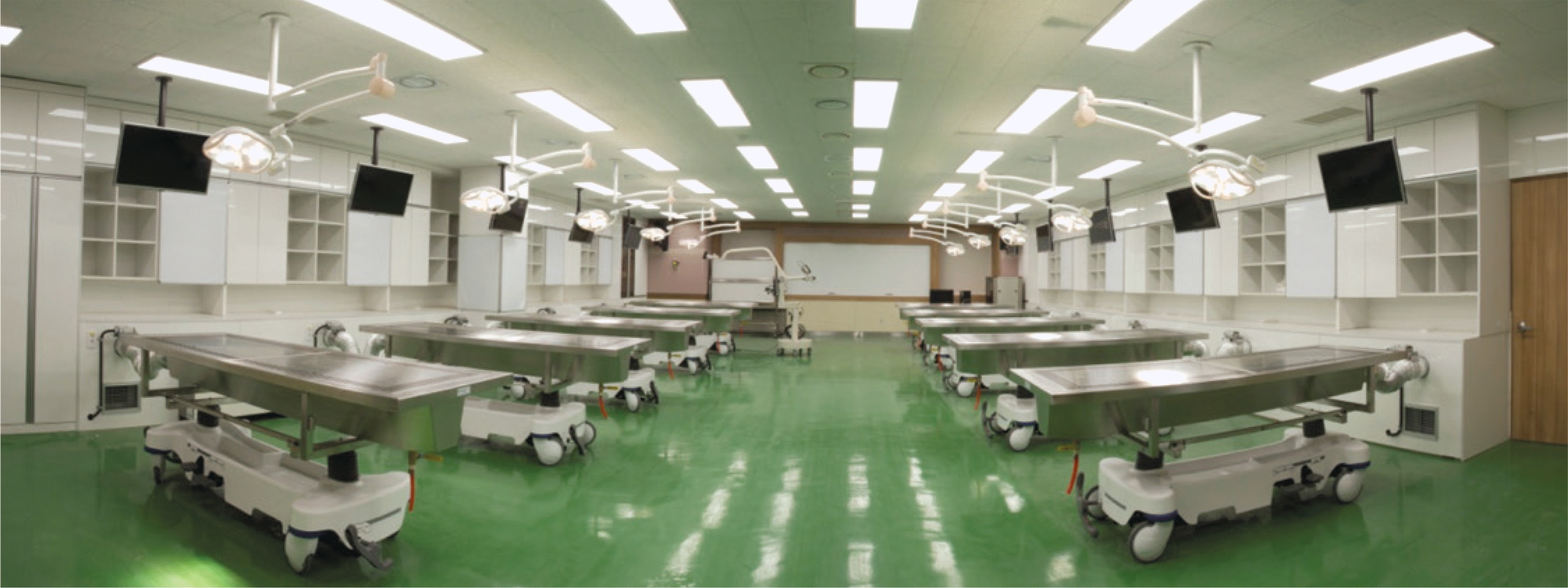Abstract
Formaldehyde (FA) used for preserving the body for anatomy dissection is harmful to the human body. In many countries, for the purpose of protecting the health of workers in the industrial field, the maximal allowable air concentration of FA has been set. The threshold limit values of time weighted average (TLV-TWA) and short-term exposure limit (TLV-STEL) of FA recommended by Ministry of Employment and Labor (MOEL) of Korea are less than 0.5 and 1 ppm, respectively. In the United States and Europe, TLV-TWAs of FA are recommended at between 0.3 and 2 ppm. In this study, we compared the air concentration of FA to domestic and foreign standards of FA in an anatomy laboratory equipped dissecting tables with inbuilt exhaust and an air diffuser/return system.
We installed ten elevated dissection tables, 18 air diffusers on the ceiling, and 10 air returns at the bottom of both side walls. The concentration of FA was measured at five sites in the anatomy laboratory and above the cadavers on the dissecting tables at a height of 1.5 m from the floor using a Formaldemeter.
The average concentration of FA in the anatomy laboratory (five sites) was 0.31 ppm (0.45 mg/m3), range 0.21 to 0.41 ppm (0.26∼0.51 mg/m3). The average concentration of FA above the cadavers was 0.45 ppm (0.56 mg/m3), range 0.31 to 0.64 ppm (0.39∼0.80 mg/m3). The average TWA of FA in the anatomy laboratory was 0.19 ppm (0.24 mg/m3), range 0.13 to 0.26 ppm. The average TWA of FA above the cadavers was 0.28 ppm (0.35 mg/m3), range 0.19 to 0.40 ppm. The anatomy laboratory dissecting tables equipped with inbuilt exhaust and air diffuser/return system met the criteria of the FA concentration recommended by MOEL of Korea and most foreign countries.
This study was the first evaluation of the air concentration of FA in an anatomy laboratory equipped dissecting tables with inbuilt exhaust and an air diffuser/return system in Korea. We expect it will be not only used as a standard of comparison for anatomy laboratories, but as a reference for design and construction to improve air quality in Korean Medical Colleges.
References
1. Baek NW. The study for revision of chemical exposure standards: Ministry of Labor. 2005. Korean.
2. Heck HD, Casanova-Schmitz M, Dodd PB, Schachter EN, Witek TJ, Tosun T. Formaldehyde (CH2O) concentrations in the blood of humans and Fischer-344 rats exposed to CH2O under controlled conditions. Am Ind Hyg Assoc J. 1985; 46:1–3.
3. Loden M. The in vitro permeability of human skin to benzene, ethylene glycol, formaldehyde, and n-hexane. Acta Pharmacol Toxicol. 1986; 58:382–9.
4. Kitchens J, Casner R, Edwards G, Harward W, Macri B. Investigation of selected potential environmental contaminants: formaldehyde. Washington DC: United States Environmental Protection Agency.;1976.
5. Morgan DP. Recognition and management of pesticide poisonings. 4th ed. Washington DC: United States Environmental Protection Agency.;1989.
6. Green DJ, Bascom R, Healey EM, Hebel JR, Sauder LR, Kulle TJ. Acute pulmonary response in healthy, nonsmoking adults to inhalation of formaldehyde and carbon. J Toxicol Environ Health. 1989; 28:261–75.

7. Kilburn KH, Seidman BC, Warshaw R. Neurobehavioral and respiratory symptoms of formaldehyde and xylene exposure in histology technicians. Arch Environ Health. 1985; 40:229–33.

8. Malaka T, Kodama AM. Respiratory health of plywood workers occupationally exposed to formaldehyde. Arch Environ Health. 1990; 45:288–94.

9. IARC. IARC monographs: formaldehyde. 2006.
10. MOEL. Exposure criteria to chemicals and physical agents. 2013. Korean.
11. MOEL. The guideline for air management of office. 2015. Korean.
12. NIOSH. Formaldehyde [Internet]. http://www.cdc.gov/niosh/idlh/50000.html.
13. OSHA. Occupational safety and health standards: formaldehyde [Internet]. https://www.osha.gov/pls/oshaweb/owadisp.show_document?p_id=10075&p_table=STAN-DARDS.
14. JSOH. Recommendation of occupational exposure limits the Japan Society for Occupational Health characteristics of OELs and instructions for users. J Occup Health. 2015; 57:394–417.
15. Kim YD, Nam Y-J, Kim H, Cho S-H. Exposure levels and prevalence of hypersensitivity to formaldehyde among medical students. Chungbuk J Med. 1993; 3:89–95. Korean.
Fig. 2.
Panorama image of the anatomy laboratory equipped dissecting tables with inbuilt exhaust and an air diffuser/return system.

Table 1.
Formaldehyde concentration.




 PDF
PDF ePub
ePub Citation
Citation Print
Print





 XML Download
XML Download